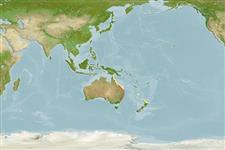Environment: milieu / climate zone / depth range / distribution range
Ekologi
laut dasar (demersal); kisaran kedalaman 10 - 20 m (Ref. 9774). Temperate
Southwest Pacific: southeastern Australia northward to southern Queensland.
Size / Weight / umur
Maturity: Lm ? range ? - ? cm
Max length : 25.0 cm SL jantan/; (Ref. 9774)
Duri punggung (Keseluruhan (total)) : 0; duri punggung lunak (Keseluruhan (total)) : 74 - 80; Duri dubur: 0; Sirip dubur lunak: 58 - 61. Body brownish with 3 ocelli above and below lateral line, and small dark rings and blotches scattered on body and median fins. Body elliptical, its depth 2.1 to 2.3 times in SL. Head length 4.1 to 4.4 times in SL. Upper profile of head with shallow notch in front of upper eye. Snout slightly protruded, shorter than eye diameter, upper-eye diameter 3.8 to 5.2 times in head length. Maxilla extending almost below middle of lower eye. Upper-jaw length 3.9 to 4.6 times in head length. Teeth in both jaws small, close-set, no enlarged canines. Gill rakers slender and rather long. Scales usually cycloid on both sides, but sometimes weakly ctenoid on anterior part of body on eyed side. Pectoral fin on eyed side with 11 or 12 rays. (Ref 9774).
Inhabits sand and mud bottoms. Feeds on small benthic animals. Caught mainly with prawn and bottom trawls.
Life cycle and mating behavior
Kematangan | Reproduksi, perkembang biakan | Pemijahan | telur-telur | Fecundity | Larva
Distinct pairing (Ref. 205).
Amaoka, K. and D.A. Hensley, 2001. Paralichthyidae. Sand flounders. p. 3842-3862. In K.E. Carpenter and V. Niem (eds.) FAO species identification guide for fishery purposes. The living marine resources of the Western Central Pacific. Vol. 6. Bony fishes part 4 (Labridae to Latimeriidae), estuarine crocodiles. FAO, Rome. (Ref. 9774)
Status IUCN Red List (Ref. 130435: Version 2024-2)
ancaman kepada manusia
Harmless
penggunaan manusia
Perikanan: komersial
Alat, peralatan
laporan khas
muat turun XML
Sumber internet
Estimates based on models
Preferred temperature (Ref.
123201): 20.4 - 25.7, mean 24.7 °C (based on 148 cells).
Phylogenetic diversity index (Ref.
82804): PD
50 = 0.5000 [Uniqueness, from 0.5 = low to 2.0 = high].
Bayesian length-weight: a=0.00724 (0.00338 - 0.01553), b=3.17 (3.00 - 3.34), in cm total length, based on LWR estimates for this Genus-body shape (Ref.
93245).
Trophic level (Ref.
69278): 3.5 ±0.37 se; based on food items.
Daya lenting (Ref.
120179): Tinggi, Waktu penggandaan populasi minimum kurang dari 15 bulan (Preliminary K or Fecundity.).
Fishing Vulnerability (Ref.
59153): Low vulnerability (21 of 100).
